
Acronym: CELLAGRI
Title: CELLulose-based mulch films with nature-inspired water management structures for AGRIculltural applications
| Call | HORIZON-EIC-2024-PATHFINDERCHALLENGES-01-03 |
| EU nr | 101223132 |
| Period | 48 months – Start date 1.10.2025 |
| Project budget | € 3 965 307.25 |
| VUB budget | € 414 900.00 |
| Contact | Prof. Wim De Malsche, Dr. Ilyesse Bihi, Ir. Filip Legein |
Can you provide a brief overview of CELLAGRI and its key objectives?
The CELLAGRI project, “Cellulose-based films with nature-inspired water collecting structures for agricultural applications”, is led by the Fraunhofer Institute for Electron Beam and Plasma Technology (FEP) and funded under the EIC Pathfinder Challenge “Nature inspired alternatives for food packaging and films for agriculture”. The consortium brings together a truly multidisciplinary and multisectoral team, including partners from Germany, Belgium, France, Slovenia, Switzerland, Sweden, and Spain.
Its key objective is to develop sustainable and biodegradable mulch films using cellulose-based materials combined with nature-inspired microfluidic structures imprinted in fully biodegradable coatings for enhanced water management. These films will offer an alternative to conventional polyethylene (PE) mulch films, which are widely used in Europe but contribute to high CO₂-equivalent emissions and microplastic pollution. CELLAGRI aims to address this by creating agricultural films that not only serve essential functions such as weed control, moisture retention, and soil temperature regulation but also integrate innovative designs inspired by nature to improve water collection and management.
What specific role does VUB play within the CELLAGRI consortium?
The µFlow group of the Vrije Universiteit Brussel (VUB) is a partner in CELLAGRI. Prof. Wim De Malsche, head of the µFlow group, emphasizes that their involvement demonstrates the potential of microfluidics as an enabling technology in unexpected fields, including agricultural film.
VUB’s role is centered on designing microfluidic structures that efficiently collect and manage water from sources like rain and sprinklers. These structures, inspired by organisms such as the Namib Desert beetle, spider silk, cacti, and pitcher plants, will be combined with plasma treatments to control surface tension. The µFlow team will model these innovative designs, fabricate them, and test them using the state-of-the-art microfabrication techniques available in the new VUB Core Facility MICROLAB. In this way, VUB contributes both fundamental expertise in microfluidics and advanced technological capacity for testing and prototyping.
How do you envision CELLAGRI contributing to broader societal and economic impact?
CELLAGRI directly addresses pressing environmental and agricultural challenges. By replacing polyethylene mulch films with sustainable and biodegradable alternatives, it has the potential to significantly reduce CO₂-equivalent emissions and mitigate microplastic pollution in soils. Beyond environmental benefits, the project envisions improved water management in drought-prone or water-stressed regions, helping agriculture cope with climate challenges from global warming.
From an economic perspective, CELLAGRI will bring together different innovative technologies—coating, imprinting, plasma treatment—that can be upscaled and integrated into a roll-to-roll process, ensuring a pathway to cost-effective manufacturing. The consortium will also develop a toolbox of technologies to produce a family of materials that can be tuned to specific crops and climate conditions. This adaptability not only benefits agricultural productivity but also generates synergies with other materials and applications developed in the Pathfinder Challenge Portfolio, amplifying the project’s impact and creating opportunities for broader industrial uptake.
